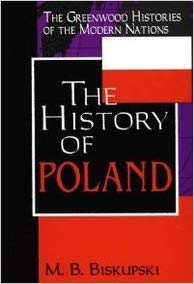Polokaust An Introductory Summary Biskupski

The History of Poland, by Mieczyslaw B. Biskupski. 2000
An Overview of the Polokaust: The Staggering Losses Inflicted By the Nazi Germans on Poland
The author generally provides a balanced account of Polish history. This book encompasses pre-Partition Poland, Poland under foreign rule, the resurrection of the Polish state (1918) with its frontier battles, the Second Republic (1918-1939), WWII (1939-1945), the Soviet-imposed Communist state in its early (1945-1970) and later (1970-1989) function, and the Third Republic. (1990-present).
TIMELESS 1939 WAR MYTHS
While discussing the 1939 campaign, Biskupski debunks some myths: the one about the Polish Air Force getting destroyed largely on the ground, and the one about Polish cavalry charging German tanks out of foolhardiness or desperation. Actually, Poles used horses for their mobility. He realizes that the horse was still widely used in combat at the time, and that the Wehrmacht, in its conquest of Poland, and notwithstanding its mechanization, still relied on almost 200,000 horses. (p. 104).
THE POLOKAUST: A SUMMARY
Perhaps the strongest part of this book is its eye-opening description of the staggering scale of Polish losses during WWII. The Germans murdered 45% of Poland’s physicians and dentists, 57% of her attorneys, 40% of her professors, 30% of her technicians, a majority of her journalists, and nearly 20% of her clergy. There was a total of 200 concentration camps in German-occupied Poland. (p. 108). The devastation was proportionately unmatched anywhere in the world, and came out to thirteen times the national income of the last prewar year, 1938. Biskupski adds, “Almost 40 percent of the entire productive capacity of the country lay in ruins, and two-thirds of the industrial base at least partially destroyed. In agriculture, two-thirds of the cattle, half of the horses, and more than 80 percent of the swine were gone, 80 percent of the railroad cars and engines were gone, the vast majority of bridges and rail lines along with them. (p. 123).
PROBLEMS WITH THIS BOOK
The author makes not-well-supported critical comments of the likes of Roman Dmowski, Smigly-Rydz, Cardinal Glemp, and Poles in Polish-Ukrainian relations. Some readers may find these remarks one-sided and tendentious.
To see a series of truncated reviews in a Category click on that Category:
- All reviews
- Anti-Christian Tendencies
- Anti-Polish Trends
- Censorship on Poles and Jews
- Communization of Poland
- Cultural Marxism
- German Guilt Dilution
- Holocaust Industry
- Interwar Polish-Jewish Relations
- Jewish Collaboration
- Jewish Economic Dominance
- Jews Antagonize Poland
- Jews Not Faultless
- Jews' Holocaust Dominates
- Jews' Holocaust Non-Special
- Nazi Crimes and Communist Crimes Were Equal
- Opinion-Forming Anti-Polonism
- Pogrom Mongering
- Poland in World War II
- Polish Jew-Rescue Ingratitude
- Polish Nationalism
- Polish Non-Complicity
- Polish-Ukrainian Relations
- Polokaust
- Premodern Poland
- Recent Polish-Jewish Relations
- The Decadent West
- The Jew as Other
- Understanding Nazi Germany
- Why Jews a "Problem"
- Zydokomuna